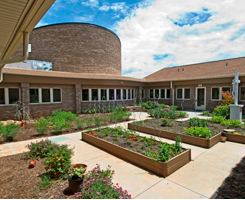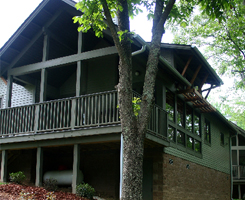Sustainable Design and Green Building
National Information
Region 4 Toolkits
Historic Preservation and Green Building
Green Building Standards, Certifications, Model Codes and Ordinances
- American Society of Heating, Refrigerating and Air-Conditioning Engineers (ASHRAE 90.1)

- Green Advantage-credential program for construction personnel

- Green Footstep - Rocky Mt. Institute

- Green Globe for Buildings

- Green Seal

- International Green Construction Code

- US Green Building Council-Leadership in Energy and Environmental Design

Professional and Trade Associations
Sustainable Design and Green Building Guides and Products
- CDC Tips for a Green Home
- DSIRE: Database of state incentives for renewables and efficiency

- EPA Green Power Locator
- Forest Stewardship Council

- Green2Green - compare green building products

- International Living Future Institute

- National Resources Defense Council - Building Green

- Savannah College of Art and Design Emergent Structures Initiatives

- Sustainable Facilities Tool

- Sustainable Sites Initiative

- Whole Building Design Guide

Contact Information
Pollution Prevention and Innovation Team
U.S. EPA Region 4
r4sustainability@epa.gov
EPA Resources for Sustainable Design and Green Building
Background
The process of designing, developing and inhabiting the built environment has a profound influence on a community's economy, health, environment, natural resources and quality of life
In the United States, buildings account for:
- 39% of total energy use
- 12% of the total water consumption
- 68% of total electricity consumption
- 38% of the carbon dioxide emissions
Sustainable Design and Green Building promotes environmental quality, economic vitality, and social benefit by integrating site selection, design, and construction and operation of the built environment with green practices.
The goal of sustainable design and green building is to reduce negative impacts on the environment, and the health and comfort of building occupants, while improving overall building performance. Sustainable design principles include the ability to:
- evaluate site potential, connectivity to communities and amenities, and reduce natural resource impacts;
- minimize non-renewable energy consumption;
- use environmentally preferable products;
- protect and conserve water;
- enhance indoor environmental quality and health; and
- optimize operational and maintenance practices over time.
Sustainable design and green building merges sound, environmentally responsible practices into one discipline that looks at the environmental, economic, and social effects of a building and the surrounding site as a whole.
How does sustainable design and green building work?
It starts with choosing a site and continues all the way through construction and eventually to demolition and recycling or deconstruction. It applies to a building's entire lifecycle. Even if you're not building a new structure, there are ways to retrofit and "green" your building or home by following these easy guidelines.
Where does it happen?
Green building is happening across the Southeast! According to a study conducted by
American City Business Journals, ![]() both Georgia and Florida are ranked in the top 10 of states for green building, while Mississippi has more
LEED certified homes than any other state with 651. For some examples and case studies in the Southeast,
please see the links below.
both Georgia and Florida are ranked in the top 10 of states for green building, while Mississippi has more
LEED certified homes than any other state with 651. For some examples and case studies in the Southeast,
please see the links below.
The Southeast Smart Growth Network, ![]() under the management of the Southeast Watershed Forum and with funding from
the US EPA Region 4, is conducting
an analysis of local government green building permitting programs in Tennessee, Georgia, North and South Carolina,
and Florida. The project will provide regional examples of best practices and provide a blueprint for how to
implement effective green building permitting programs in other communities across the south. The results from
the study will be posted when the project is complete.
under the management of the Southeast Watershed Forum and with funding from
the US EPA Region 4, is conducting
an analysis of local government green building permitting programs in Tennessee, Georgia, North and South Carolina,
and Florida. The project will provide regional examples of best practices and provide a blueprint for how to
implement effective green building permitting programs in other communities across the south. The results from
the study will be posted when the project is complete.
EPA Resources for Sustainable Design and Green Building
EPA programs, tools, publications, and tips related to sustainable design and green building.
EPA Region 4 White Paper on Sustainable Design and Green Building for Resilient and Adaptable Communities
The EPA Region 4 White Paper on Sustainable Design and Green Building for Resilient and Adaptable Communities (PDF) (4 pp, 171KB, About PDF) addresses the interelated nature of resilience, sustainability, and climate change adaptation and how they relate to green building.
Case Studies
The southeast has many significant achievements in green building, including the case studies below. These examples show how the green building techniques can be applied to a variety of structures -- schools, churches, colleges, homes, commercial and government buildings -- throughout the region.
| Georgia- Design for Disassembly House | Kentucky - Liberty Green Community Center |

|
 |
|
South Carolina - Monastery of St. Clare |
Tennessee - Green Cabins at David Crockett State Park |

|

|
Also: Florida - HGTV 2009 Green Home and South Carolina - 113 Calhoun Street, Charleston
![]()
Energy Star
Energy Star is a joint program of the U.S. Environmental Protection Agency and the U.S. Department of Energy aimed at helping consumers save money and protect the environment through energy efficient products and practices.
- The Energy Star program focuses on environmentally efficient products for Home Improvement, New Homes, and Buildings & Plants.
- Structures must meet high standards in order to earn Energy Star recognition. The standards change with new technology.
- Installing Energy Star qualified appliances can help earn buildings qualify for green building certification programs.
Lifecycle Building Challenge
|
The Lifecycle Building Challenge
|
|
The overarching goal of the Challenge is to create functional buildings that minimize waste, energy consumption, and greenhouse gas emissions. |
|
Awards are given to U.S. and international winners for existing and new building plans. Special achievements are recognized in categories such as Greenhouse Gas Reduction and Climate Adaptation. |
![[logo] US EPA](../gif/logo_epaseal.gif)